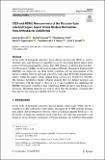Files in this item
DEER and RIDME measurements of the nitroxide-spin labelled copper-bound amine oxidase homodimer from arthrobacter globiformis
Item metadata
| dc.contributor.author | Russell, Hannah | |
| dc.contributor.author | Stewart, Rachel | |
| dc.contributor.author | Prior, Christopher | |
| dc.contributor.author | Oganesyan, Vasily S. | |
| dc.contributor.author | Gaule, Thembaninkosi G. | |
| dc.contributor.author | Lovett, Janet E. | |
| dc.date.accessioned | 2021-04-08T11:30:17Z | |
| dc.date.available | 2021-04-08T11:30:17Z | |
| dc.date.issued | 2021-03-29 | |
| dc.identifier | 273354547 | |
| dc.identifier | b667cc4d-7366-4627-8b5e-17c6f7b6ac03 | |
| dc.identifier | 85103353718 | |
| dc.identifier | 000634626900001 | |
| dc.identifier.citation | Russell , H , Stewart , R , Prior , C , Oganesyan , V S , Gaule , T G & Lovett , J E 2021 , ' DEER and RIDME measurements of the nitroxide-spin labelled copper-bound amine oxidase homodimer from arthrobacter globiformis ' , Applied Magnetic Resonance , vol. First Online . https://doi.org/10.1007/s00723-021-01321-6 | en |
| dc.identifier.issn | 0937-9347 | |
| dc.identifier.other | ORCID: /0000-0002-3561-450X/work/92020067 | |
| dc.identifier.uri | https://hdl.handle.net/10023/22985 | |
| dc.description | Authors acknowledge financial support from EPSRC (studentship to HR EP/R513337/1, Grant support to VSO EP/P007554/1, Grant support to TGG EP/L015005/1), The Royal Society (URF to JEL URF150698), and The Wellcome Trust for a multi-user equipment grant (099149/Z/12/Z). | en |
| dc.description.abstract | In the study of biological structures, pulse dipolar spectroscopy (PDS) is used to elucidate spin–spin distances at nanometre-scale by measuring dipole–dipole interactions between paramagnetic centres. The PDS methods of Double Electron Electron Resonance (DEER) and Relaxation Induced Dipolar Modulation Enhancement (RIDME) are employed, and their results compared, for the measurement of the dipolar coupling between nitroxide spin labels and copper-II (Cu(II)) paramagnetic centres within the copper amine oxidase from Arthrobacter globiformis (AGAO). The distance distribution results obtained indicate that two distinct distances can be measured, with the longer of these at c.a. 5 nm. Conditions for optimising the RIDME experiment such that it may outperform DEER for these long distances are discussed. Modelling methods are used to show that the distances obtained after data analysis are consistent with the structure of AGAO. | |
| dc.format.extent | 21 | |
| dc.format.extent | 967748 | |
| dc.language.iso | eng | |
| dc.relation.ispartof | Applied Magnetic Resonance | en |
| dc.subject | QC Physics | en |
| dc.subject | DAS | en |
| dc.subject.lcc | QC | en |
| dc.title | DEER and RIDME measurements of the nitroxide-spin labelled copper-bound amine oxidase homodimer from arthrobacter globiformis | en |
| dc.type | Journal article | en |
| dc.contributor.sponsor | The Wellcome Trust | en |
| dc.contributor.institution | University of St Andrews. School of Physics and Astronomy | en |
| dc.contributor.institution | University of St Andrews. Biomedical Sciences Research Complex | en |
| dc.identifier.doi | 10.1007/s00723-021-01321-6 | |
| dc.description.status | Peer reviewed | en |
| dc.identifier.url | https://link.springer.com/article/10.1007%2Fs00723-021-01321-6#Sec19 | en |
| dc.identifier.grantnumber | 099149/Z/12/Z | en |
This item appears in the following Collection(s)
Items in the St Andrews Research Repository are protected by copyright, with all rights reserved, unless otherwise indicated.

